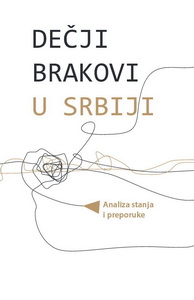 Despite numerous efforts to prevent the possibility of forcing minors and children into marriages, this phenomenon is still present, and it represents one of the most pressing issues in both Serbia and the World. As their contribution to the prevention and neutralization of this phenomenon, the “Ana and Vlade Divac” Foundation and the NGO “Atina” completed the survey called “Child Marriages in Serbia – Situation Analysis and Recommendations”.
Despite numerous efforts to prevent the possibility of forcing minors and children into marriages, this phenomenon is still present, and it represents one of the most pressing issues in both Serbia and the World. As their contribution to the prevention and neutralization of this phenomenon, the “Ana and Vlade Divac” Foundation and the NGO “Atina” completed the survey called “Child Marriages in Serbia – Situation Analysis and Recommendations”.
The Survey states that child marriages represent the practice when the child is forced to enter a marriage with another child or with an adult and that this phenomenon mostly affects girls. Furthermore, the Survey states that the causes for this are numerous, and regardless of the general opinion that they are entirely a product of a traditional lifestyle and customary law of particular communities, precise reasons can be found in every single case; they can be personal, financial, political or some other. It also emphasizes that child marriages have severe and grave consequences for children who enter into them and that they lead to their objectification, elimination of any possibility for personal growth as a result of early parenthood, and to the exposure to chronic poverty and illiteracy.
The Survey highlights the need for a comprehensive, continuous and coordinated action of all relevant government institutions and civil society organizations, and the need to diversify and localize activities in order for this issue to be adequately addressed. Four key courses of action in the prevention of this phenomenon are: empowerment of girls; mobilizing families and communities; providing access to services, and the adoption of laws and policies. Also, it is particularly emphasized that for the eradication of this phenomenon it is essential to separate the practice of child marriage from any ethnic or religious traditions, thus label it as anachronistic social and not as Roma practice, regardless of the fact that it is dominant within this community.
 Government of the Republic of Serbia
Government of the Republic of Serbia















 pdf [271 KB]
pdf [271 KB]
Leave a Comment